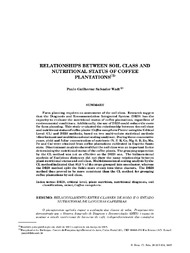Relationships between soil class and nutritional status of coffee plantations.
Relationships between soil class and nutritional status of coffee plantations.
Author(s): WADT, P. G. S.
Summary: Farm planning requires an assessment of the soil class. Research suggest that the Diagnosis and Recommendation Integrated System (DRIS) has the capacity to evaluate the nutritional status of coffee plantations, regardless of environmental conditions. Additionally, the use of DRIS could reduce the costs for farm planning. This study evaluated the relationship between the soil class and nutritional status of coffee plants (Coffea canephora Pierre) using the Critical Level (CL) and DRIS methods, based on two multivariate statistical methods (discriminant and multidimensional scaling analyses). During three consecutive years, yield and foliar concentration of nutrients (N, P, K, Ca, Mg, S, B, Zn, Mn, Fe and Cu) were obtained from coffee plantations cultivated in Espírito Santo state. Discriminant analysis showed that the soil class was an important factor determining the nutritional status of the coffee plants. The grouping separation by the CL method was not as effective as the DRIS one. The bidimensional analysis of Euclidean distances did not show the same relationship between plant nutritional status and soil class. Multidimensional scaling analysis by the CL method indicated that 93.3 % of the crops grouped into one cluster, whereas the DRIS method split the fields more evenly into three clusters. The DRIS method thus proved to be more consistent than the CL method for grouping coffee plantations by soil class.
Publication year: 2005
Types of publication: Journal article
Unit: Embrapa Acre
Keywords: Análise estatística, Análise multivariada, Análisis de multivarianza, Análisis estadístico, Café, Café Conilon, Clasificación de suelos, Classes de solos, Classificação do solo, Coffea canephora, Coffee, DRIS Method, Estado nutricional, Estatus nutricional, Level Critical Method, Multivariate analysis, Método DRIS, Método do Nível Crítico, Nutrición de las plantas, Nutritional status, Planejamento agrícola, Plant nutrition, Soil classification, Statistical analysis
Observation
Some of Embrapa's publications are published as ePub files. To read them, use or download one of the following free software options to your computer or mobile device. Android: Google Play Books; IOS: iBooks; Windows and Linux: Calibre.
Access other publications
Access the Agricultural Research Database (BDPA) to consult Embrapa's full library collection and records.
Visit Embrapa Bookstore to purchase books and other publications sold by Embrapa.

